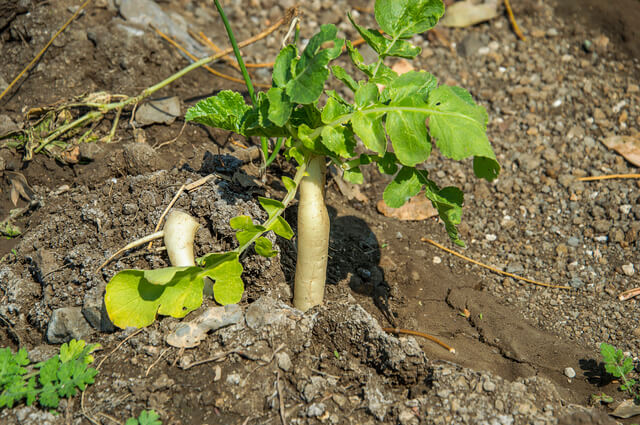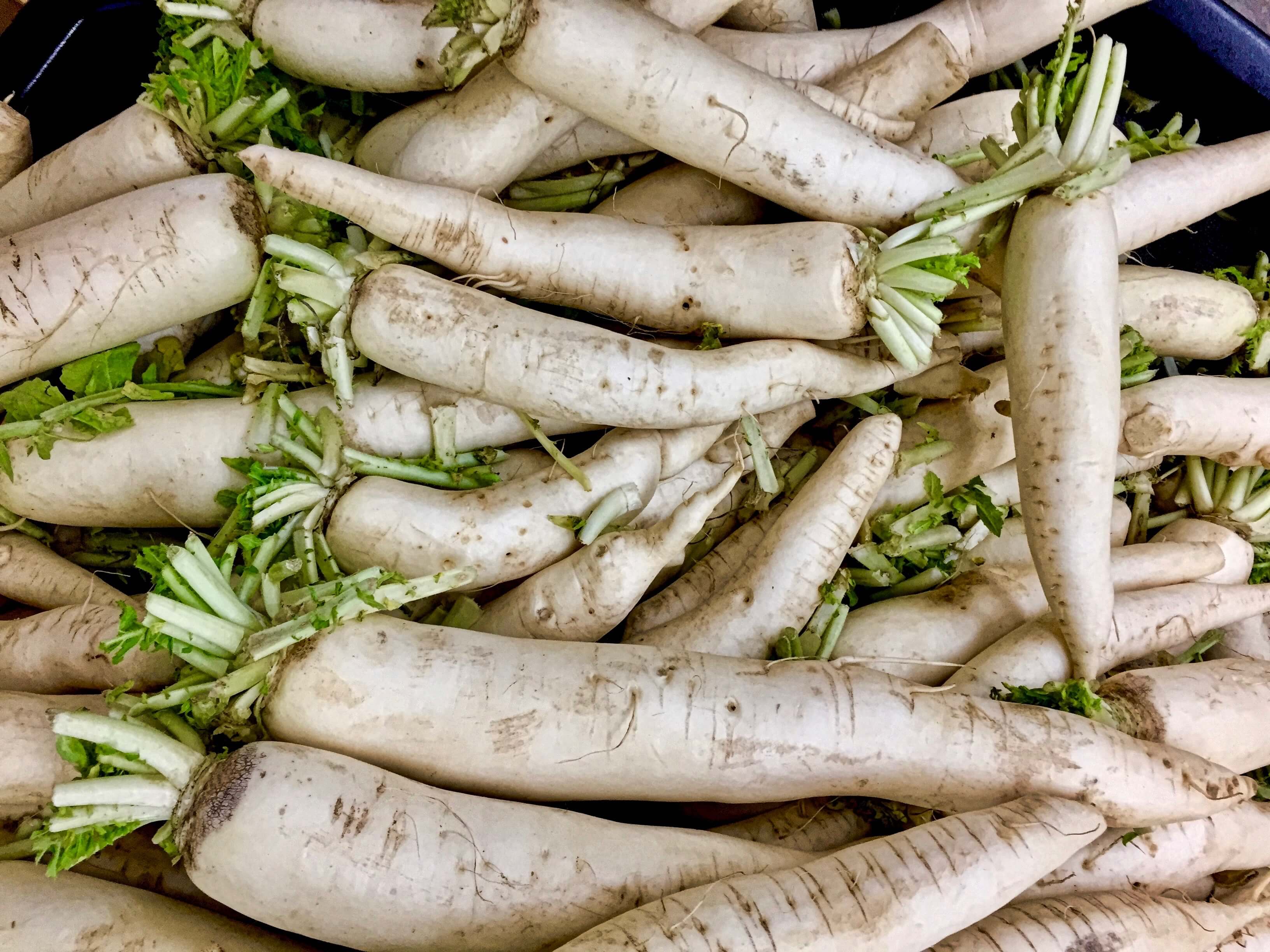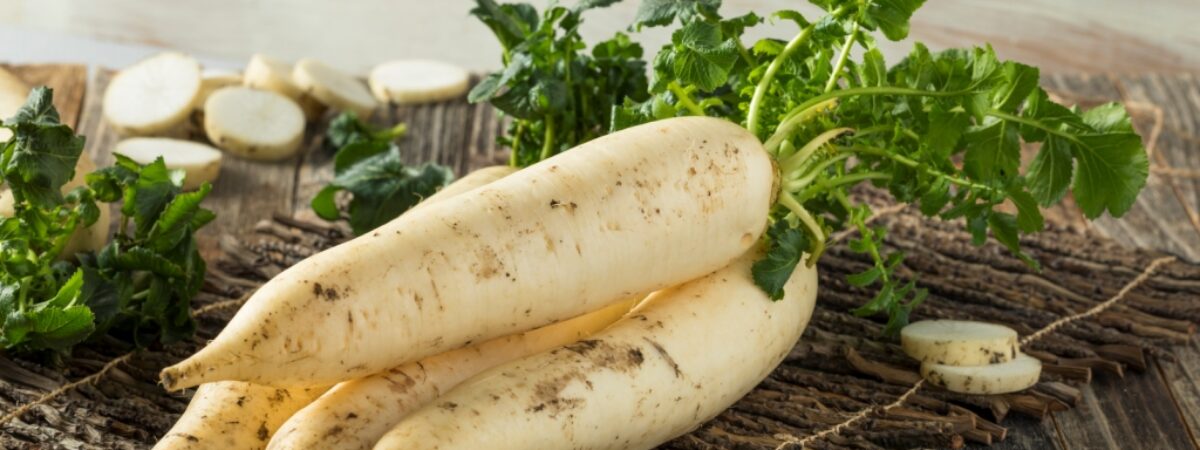WHAT IS DAIKON RADISH?
Daikon Radish (Raphanus sativus longipinnatus)- mooli, otherwise known as Japanese Radish, Chinese Radish, Oriental Radish, Long White Radish and Winter Radish is a variety of radish mainly native to China and Japan.
Originating from Southeast or East Asia, these are also known as ‘big roots’ in Japanese. Hence, the word Daikon comes from two japanese words: dai means large and kon means roots.
It is a root vegetable and belongs to the Brassicaceae family resembling the shape of a carrot and the flavor is mildly like a red radish.
Raw daikon adds a rich flavor to many dishes due to its creamy white flesh and bright, juicy, and crisp texture. It has a beautiful blend of slightly sweet yet peppery flavor. They taste great with many herbs as well.
The leaves of the Daikon radishes are also edible, they give a bit of grassy and pungent taste. These are mainly used in salads and soups.
Apart from cultivating Daikon Radish for food , the leaves of Daikon radish is also used as fodder crop as in North America. Cosmetic industry used the seed oil of Daikon radish.
Another interesting fact is that some varieties of Daikon radish are known as ‘tillage radish’ as it has deeper roots to perform better cultivation and works as green manure and cover crops.
TYPES OF DAIKON RADISHES
Daikon radishes not only come with white and green tops, but also come in purple, red, and green hues
It comes in three main shapes; Spherical, Cylindrical and Oblong.
Some Interesting types are as follows:
Shunkyo
This is a cylindrical variety that originated from Northern China with pink roots,stems and white flesh . It can be grown throughout the year and grows up to a height of 4-5 inches.
It has a mild sweet and spicy taste. These are traditionally used as pickles.
Watermelon Radish
This is an heirloom variety of Daikon radish and is spherical in shape. They originated from china. It looks pale green from outside but has a deep red centre to pink color when sliced.
The taste of this radish doesn’t resemble that of a watermelon; rather, the color of the radish justifies the name.
It takes around 30-80 days for harvesting. Like the Shunkyo variety, these also make great pickles. It has the same crispy, slightly sweet and peppery taste.
KN- Bravo
This is a long and beautiful purple variety of Daikon radish. These are hybrid and are available throughout the year. It originated from Korea and is also known as korean radish.
It has purple skin and white flesh. It tastes a bit sweet and peppery, imparts a beautiful color when added to salads and kimchi and it can grow upto 8 inches long.
Along with the beauty, these radishes are also rich in vitamins A, B6, C and E.

Miyashige White
These are white colored with cylindrical shaped roots. They have large roots penetrating deeper into the soil and hence can be used as cover crops. They have mild crispy flavor and are used in pickling and storage. These are best sown in late summer to harvest in fall.
Alpine
These are traditional Korean radishes often used to make kimchi- a fermented vegetable dish. They possess shorter roots i.e. 5 inches long.
It tastes sweet as compared to other long Daikon varieties. These are commonly grown in Korea and are suitable for late summer or early fall sowing. These can also be grown in gravelly soil.
Japanese Minowase
This is an ancient Japanese radish with one of the largest varieties with roots growing up to 24 inches long. The roots are white colored and have a crispy texture. It has a mild sweet flavor that enhances the taste of dishes and hence are used in most asian cuisines.
The best part is that these radishes have high keeping quality and can be stored for many weeks. These are cool season varieties and can tolerate partial shade to full sun. It takes 45 days to harvest.
Daikon radish is mainly a winter radish, so it is mostly planted during mid summer to early fall and is harvested during the winter season. Click To TweetHOW TO GROW DAIKON RADISH?
Daikon radish is mainly a winter radish, so it is mostly planted during mid summer to early fall and is harvested during the winter season. Long warm nights and hotter climates will prevent root growth. The best part is that growing Daikon radish is comparatively easier than other crops.
These are larger than spring radishes and grow slowly and hence have larger roots.
Daikon radishes are grown around the world despite being native to Asia.
The length of time to maturity and the average date of the first frost in an area should be considered when choosing daikon varieties.
Soil Conditions
They require well drained and friable soils having a pH of 5.8-6.8 that are amended with compost. Compacted clayey soils are not suitable for growing these radishes and hence the compacted soils are loosen with broadfork before planting the seeds.
The best method to sow Daikon seeds is by direct seeding method in raised beds. This helps in quick germination of seeds. Spacing between the seeds should be 12-18 inches in rows and 1/2 -1/4 inches deep.
It’s best to avoid overfertilizing the soil mainly with nitrogen as it will provide nutrition to the plant and prevent root growth. Roots should be allowed to grow freely so that they can lose the soil below.
Mixing good quality garden soil helps provide nutrition for better growth of roots.

Climatic Condition
Partial shade to full Sun condition gives the best result to grow Daikon Radish. Proper amount of Sunlight helps in bigger root growth. High heat leads to stunted growth. It grows well in moderate to high humidity.
Watering
When it comes to watering these Daikon Radishes, it’s quite tricky.
The important point is that we need to keep the soil moist not wet, so overwatering should be avoided but soil should be left moist for longer duration.
When the climate is warmer, water the plants before sunlight comes in order to retain the moisture and when the weather is cooler check the dampness of soil to know whether wateroing is required or not.
The best method is drip irrigation for these radishes. Mulching can also be done to retain moisture as well.
When growing daikon in the garden, many gardeners use the trick of planting successively for about two weeks. In this way, when the previously planted Daikons are ready for harvest, the younger plants will still be growing.
Pests and diseases
Daikon is rarely affected by pests.
However, some common insects are Flea Beetles, which cut regular holes in leaves. Row covers and a light dusting of diatomaceous earth will prevent insects from feeding on daikon.
Cabbage loopers eat the leaves before they mature and can be prevented by using a fungicide like Spinosad.
Aphids feed on leaves and don’t allow roots to mature. Spraying neem oil can help prevent aphid attack.
Overwatering and planting in infected soil can cause fungal and bacterial infections in brassicas.
Black rot is mainly caused by excessive wet conditions. Its better to prevent the wet condition.
How to harvest Daikon Radish?
Daikon radish takes around 30 – 80 days to mature. It is always recommended to check the maturation time and frost date that is listed in the package of chosen variety.
It will give a clear idea when the radish is to be harvested. In order to harvest the radish, first we need to check the length of the leaves.
If it is approximately 8 inches long then the leaf bundles can simply be held just above the root and pulled gently so that the entire root can quickly emerge or else it can lead to breakage.
Daikon radishes should be harvested before the heavy frost comes or else It may lead to root rot disease.
Storing of Daikon Radish
The roots and leaves should be separated before storing the radishes, it helps in storing them for a longer time. To retain moisture, we should wrap the roots in a slightly moist towel and store them in the refrigerator for about 3- 4 weeks. This prevents the roots from becoming hard.
Other preferred ways to store Daikon are Blanching and Pickling.
Blanching
Slice the daikons into thin pieces and then immerse it in boiling water for 2-3 minutes . Remove it and quickly immerse the sliced daikons into ice cold water to slow down the cooking process. Then spread the slices in a towel and let it dry completely.
These slices can be stored in a freezer in ziplock bags and can be used in soups or for stir frying.
Pickling
As the daikons are rich in nutrients, pickling them can give the benefit to have these year round. Daikons are sliced and then combined in salt or sugar solution and then stored in a mason jar in the refrigerator.

RECIPES
Daikon radish is an adaptable harvest in the kitchen. You can eat it raw if you would like to or can cook it as well.
There is no need to peel this vegetable, however, certain individuals decide to do as such. One basic method for eating daikon is to slice it into pieces that can be plunged in hummus
One more extraordinary method for eating daikon is to dice it into 0.5 inch solid shapes and afterward saute them in oil with garlic and ginger for a while. Now you can toss the sliced radishes with rice noodles, soy sauce, sesame oil, and hot pepper or hot pepper drops.
Because of their harsh surface, the leaves are best delighted in cooking by means of techniques including sauteing and steaming. They make an extraordinary expansion to Thai-enlivened coconut curries.
CONCLUSION
Now that you have read this entire article, you must have gained a fair knowledge of how to plant and develop these amazing radishes. So it’s time to add the dash of this wonderful versatile vegetable to your winter garden. You’ll be amazed to see them grow in your own backyard and enjoy the crunchiness in your daily diet.
You may also like to read
How to grow Radish – The Fast Growing Root Vegetable
List of Cruciferous Vegetables – 15 Popular Green Crops to Grow at Home






